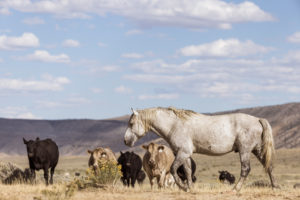FOR IMMEDIATE RELEASE September 13, 2021
Media Contacts:
Laura Cunningham, Western Watersheds Project, (775) 513-1280, lcunningham@westernwatersheds.org
Diana Oppenheim, Founder, ForELK, Action@forelk.org
POINT REYES, Calif.—In a long-awaited and contentious decision, the National Park Service today issued a final Point Reyes National Seashore General Management Plan amendment, which has for the past several years been undergoing public comment and agency analysis. The plan calls for extending (and diversifying) industrial agriculture with no lessening of chronic cattle grazing, manure dumping on park lands, and hazing and shooting of native free-ranging tule elk if they migrate into public park lands leased for livestock grazing.
“The Park Service has long been making management decisions on this National Seashore that favor commercial cattle ranching on the park’s public lands at the expense of deteriorating native ecosystems,” said Laura Cunningham, California Director at Western Watersheds Project. “With this final decision, the National Seashore intends to double down on the Trump plan to increase livestock grazing and associated commercial agricultural production for the next 20 years, instead of focusing on protecting the wildlife and enhancing recreational tourism.”
The final decision chosen by the National Park Service (NPS), Alternative B, will enshrine beef and dairy cattle grazing in the popular Seashore and northern portion of Golden Gate National Recreation Area under new 20-year leases, in place of the previous 5-year leases that had expired. The final plan adopts the “preferred” alternative drafted under the Trump administration and favored by the ranching community, whereas the vast majority of the public – and environmental groups – demanded an alternative that would have ended commercial livestock operations and managed the National Seashore for healthy and natural ecosystems.
“Cattle are destroying native coastal grasslands, spreading invasive weeds, and polluting the streams and beaches where park visitors recreate,” said Cunningham. “Commercial livestock operations are clearly an incompatible use on a National Seashore, and long past time for the cows to go.”
The National Seashore was designated by Congress in 1962. Over the subsequent few years, the government purchased land from the ranchers to assemble the park unit, extending them Reservations of Use and Occupancy — effectively the right to stay on and work the land for a specified duration – guaranteed to last the lifetime of the original owner or a maximum of 25 years.
Conservation groups expected this outcome, and are concerned about the future impairment of National Park Service resources from the large number of cattle grazing these public lands—ancestral homelands of the Coast Miwok people.
The management plan for the 28,000 acres of beef and dairy leases in Point Reyes National Seashore and the northern district of Golden Gate National Recreation Area includes such newly allowable commercial activities such as sheep ranching, ranch tours, AirBnBs, and the potential for chicken farming and row crops with future site-specific environmental reviews.
The public let the Park Service know their overwhelming support for native wildlife like the noble Tule elk, delivering over 100,000 signatures to the Department of the Interior opposing the plan, organized by grassroots activists with ForELK. The California Coastal Commission received over 45,000 comments opposing livestock operations at the Seashore.
“Point Reyes, like all public lands, belongs to all of us,” said Diana Oppenheim, Founder of ForELK. “We have worked to showcase the bias the National Park Service has toward private ranching interests at the expense of water quality, habitat degradation, land access, and the lives of the Tule elk. This decision is not supported by the people, and is a step backwards in the fight for wildlife protections.”
The newly designated Ranchland Zone would be subzoned into Ranch, Pasture, Range, and some Resource Protection Zones.
Yet conservationists hold that the original intent of Point Reyes National Seashore was quite different: Ranches were bought out and given specific timeframes to move to private lands, in order to restore the natural resources of the park and further public recreation along the Pacific coast.
“Given the focus on extending livestock-related problems, litigation over the new plan seems likely,” Cunningham added.
####






